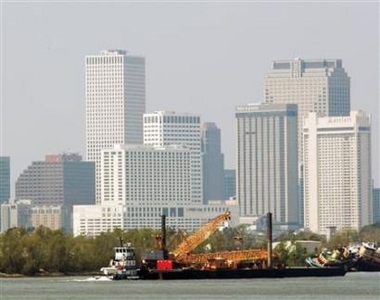New Orleans: "Visionaries Wanted," article by Nicholas Von Hoffman, from The Nation.
 A tugboat pushes a barge up the Mississippi River into the Port of New Orleans, Louisiana September 14, 2005. (Brian Snyder/Reuters)
A tugboat pushes a barge up the Mississippi River into the Port of New Orleans, Louisiana September 14, 2005. (Brian Snyder/Reuters)(Von Hoffman's work was discussed in a blog entry in March, "The building blocks of neighborhood revitalization" which is reprinted here--
The book House by House, Block by Block: Rebuilding America's Urban Neighborhoods, by Alexander von Hoffman, details success stories in urban revitalization. According to the book, there are five common threads to stitching a challenged community back together:
- A sense of place. A community has to see itself as worth saving. It needs a central idea around which people can coalesce - whether it's a history visible in cobbled streets and gaslights, a central church or school about which people who've stayed in the neighborhood have fond memories, or something as simple as a name.
- A group of tenacious leaders, reflective of the whole community. Reviving neighborhoods need "people with a certain kind of courage - maybe even foolish courage - in the face of devastation," says von Hoffman. That doesn't mean one charismatic leader. It means a broad coalition, including the "usual voices" - activists, religious and political leaders, philanthropists, developers - and voices less commonly heard: members of all the area's major ethnic groups, ordinary citizens who've never been politically active in their lives.
- A problem, and good conversation about it. Groups start with a shared sense that their community has a problem. They probably don't agree on what that problem is, and they certainly don't agree on what to do about it. So the first step is to facilitate an exchange in which every voice gets heard, every grievance aired. This is a slow process, as everyone who's taken part in such a conversation acknowledges, because fundamentally it's about trust, and trust doesn't happen on a deadline. If participants have the patience to see the process through, however, they almost invariably arrive at a common sense of the problem they're facing - and a common vision of how to tackle it.
- A sustainable plan, and the people who can implement it. At some point, though, it's time to stop talking and get practical. Community groups that aim for less - rehabbing a single building, constructing a swimming pool, repaving a street - often stop there, having failed to look systemically at what their area needs and what steps might really get them there.
- Political support. The strongest coalition with the best plan is worthless without political leaders who take it seriously. Realistically, Chrislip says, you can't expect politicians to be behind every new neighborhood initiative that starts up. But the sooner they start coming to meetings, seeing a group's seriousness about change, and being engaged in the process, the better for that neighborhood's future.)
_________________
By Nicholas Von Hoffman, Visionaries Wanted.
In the spirit of top-down government, talk abounds about the appointment of a czar, kaiser or gauleiter to run the reconstruction of the Gulf communities destroyed by Hurricane Katrina. The name of Jack Welch, former General Electric CEO, is mentioned. He'd be perfect, famous, as he is, for his considerate treatment of subordinates.
The hundreds of thousands of low- and moderate-income people whose lives have been blasted are not heard from. Nor will they be, scattered and unorganized as they are. If reconstruction continues in the direction it has been going, the displaced will get what they are given and can start practicing how to look grateful for it.
These people could be organized to have a voice in their own destinies. The Industrial Areas Foundation, which has organized scores of low- and moderate-income communities across the country, including in Texas and Mississippi, has the organizers with the skills and experience to mobilize marooned and powerless people. With organization comes democratic decision-making.
The rebuilt communities do not have to resemble penitentiaries or other forms of government housing. There are architects and developers who have made it a specialty to work with limited-income communities to design and build what people want. Among them are Telesis Corporation of Washington, DC, the brainchild of Marilyn Melkonian, with many low-income home developments to her credit. In Chicago, there is Archeworks, founded by architect Stanley Tigerman, who, with his wife, Margaret McCurry, a gifted architect also, has a long history of working with community groups.
Among the architects and designers qualified by experience and prizewinning results to collaborate with grassroots organizations are: Urban Design Associates in Pittsburgh; Calthorpe Associates in Berkeley; Pyatok Architects in Oakland; Moule & Polyzoides Architects and Urbanists in Pasadena; and, in Boston, Goody Clancy.
Grandiose talk aside, in the practical realm the skill, talent and experience is available to take this catastrophe and turn it into a political, social and design marvel. This thing doesn't have to be another hack politician, crony boy, bureaucratic morass that produces more excuses than homes. If a couple of the big foundations, for once in their cunctatious lives, got on this fast, instead of a top-down disaster we could have a bottoms-up triumph.
____________
Also see these op-ed pieces in today's Post, Back to Trent Lott's House by Anne Applebaum, and Master of the Poison Pill by Harold Myerson, as well as Trying to Resurrect the Body of a City Buried in Sludge and History in today's New York Times. Also, check out the National Main Street Center website for preservation-oriented information about post-Katrina recovery.
 Though flooding has receeded several feet in many areas of New Orleans, water is still high in some neighborhoods.(Rick Loomis / LAT)
Though flooding has receeded several feet in many areas of New Orleans, water is still high in some neighborhoods.(Rick Loomis / LAT)



1 Comments:
I was so anxiuos to know what my husband was always doing late outside the house so i started contacting investigators and was scamed severly until i almost gave up then i contacted this one private investigator and he delivered a good job showing evidences i needed from the apps on his phone like whatsapp,facebook,instagram and others and i went ahead to file my divorce papers with the evidences i got,He also went ahead to get me back some of my lost money i sent to those other fake investigators,every dollar i spent on these jobs was worth it.Contact him so he also help you.
mail: premiumhackservices@gmail.com
text or call +1 7078685071
Post a Comment
<< Home